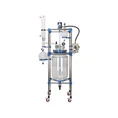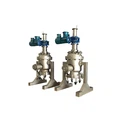How to Use Supercritical CO2 Extraction?

Are you curious about how the active ingredients in your daily decaffeinated coffee, the natural essential oils you use, or even some cutting-edge medications are safely and efficiently extracted? The answer may lie in a "green" high-tech process called supercritical CO2 extraction. The core of this technology is supercritical CO2 extraction equipment, which uses carbon dioxide in a special state as a solvent to separate high-purity target ingredients from natural substances without leaving any toxic residues.
As traditional solvent extraction methods increasingly face environmental and safety concerns, supercritical fluid extraction (SFE) technology, with its unique advantages, is becoming a new favorite in industrial production. It not only ensures final product purity but also offers customers higher product premiums, reduced operational risks, and faster market compliance. Below, we'll provide an in-depth understanding of the principles of this technology, its equipment components, and its complete operational process.
Key Takeaways: What You Need to Know?
Supercritical CO2 extraction is a highly efficient and environmentally friendly separation technology. Its core principle is to utilize CO2 in a supercritical state, which combines the high permeability of gases with the solubility of liquids. This technology is widely used in various industries, including pharmaceuticals, food, and cosmetics. It ensures high-purity extracts without residual solvents, making it an ideal alternative to traditional organic solvent extraction.
Understanding the Supercritical CO2 Extraction Principle
a Supercritical Fluid
A supercritical fluid is a state of matter that occurs when both the temperature and pressure exceed its critical point. In this state, it is neither liquid nor gas, but rather exhibits unique properties. For example, it possesses the low viscosity and high diffusivity of a gas, allowing it to easily penetrate the tiny pores of a solid matrix; at the same time, it possesses the density and solubility of a liquid, enabling it to dissolve target substances.
Is CO2 the Ideal Solvent?
Among various supercritical fluids, CO2 is widely favored due to its multiple advantages. First, CO2's critical temperature (31.1°C) and critical pressure (7.38 MPa) are relatively mild, allowing the extraction process to be carried out at lower temperatures, making it ideal for the extraction of heat-sensitive substances. Second, CO2 is non-toxic, non-flammable, residue-free, and inexpensive. Most importantly, by simply varying the temperature and pressure, the density and solvency of CO2 can be precisely controlled, enabling the precise and selective extraction of target components.
Essential Components of an SFE System
A complete set of supercritical CO2 extraction equipment is the key to achieving efficient extraction. It is well designed and highly automated.


The Complete Step-by-Step Extraction Process
Step 1: Raw Material Preparation
First, the substance to be extracted, whether a plant or other material, needs to be pre-treated. This often involves grinding it into a powder or granules to increase its surface area for contact with the CO2, thereby improving extraction efficiency.
Step 2: Pressurization and Temperature Control
Liquid CO2 is pumped into the system by a high-pressure pump and heated to reach or exceed its critical temperature (31.1°C) and critical pressure (7.38 MPa), forming a supercritical fluid.
Step 3: The Extraction Phase
The supercritical CO2 fluid is then pumped into the extractor containing the raw material. At the set pressure and temperature, it penetrates the material and selectively dissolves the target compounds. This process can be operated in either a static or dynamic mode, as needed.
Step 4: Separation and Fractionation
After extraction, the supercritical CO2 fluid carrying the target compounds enters the separator. Here, by adjusting the pressure and temperature, different extracts can be separated in stages. For example, non-polar components can be separated first, followed by less polar components by changing conditions, achieving multi-stage fractionation.
Step 5: Solvent Recovery and Product Collection
In the separator, the CO2, now in gaseous form, is collected and recycled by a compressor for reuse. This not only saves costs but also highlights the environmental benefits of the technology. Finally, the high-purity extract is collected in a receiving vessel.
Optimizing Your Extraction: Key Parameters and Troubleshooting
The Role of Pressure and Temperature
Pressure and temperature are the two most important parameters in supercritical CO2 extraction. By increasing pressure and temperature, the density of the CO2 increases, thereby enhancing its dissolving power. Conversely, lowering the pressure and temperature weakens its dissolving power. Understanding how these parameters affect extraction efficiency is key to achieving precise control.
Flow Rate and Extraction Time
The flow rate of the CO2 fluid and the extraction time are equally important. A faster flow rate can carry away more extract, but an excessively fast flow rate may lead to insufficient extraction. Optimizing flow rate and extraction time is crucial for balancing efficiency and yield.
Co-Solvent Addition: When and Why?
For some compounds with stronger polarity, pure supercritical CO2 may have limited dissolving power. In such cases, a small amount of a co-solvent, such as ethanol, can be added to modify the polarity of the CO2 and improve extraction efficiency. This makes the technology more versatile for processing a wider range of materials.
Common Challenges and Solutions
In practice, you might encounter issues such as low extraction efficiency or unsatisfactory product purity. These problems are often related to improper raw material preparation or incorrect parameter settings. By precisely controlling the temperature, pressure, and flow rate, and adjusting the process based on the specific material properties, these challenges can be effectively resolved. If you encounter a problem that is difficult to solve, it is wise to contact a professional equipment supplier for a customized solution.
Real-World Applications of SFE Technology
Pharmaceutical and Natural Products
Supercritical CO2 extraction technology is widely used in the pharmaceutical and natural product extraction fields. It is commonly used to extract active ingredients from herbs, such as ginsenosides, and to prepare high-purity natural drug raw materials. This technology guarantees residue-free extracts, meeting the stringent standards of the pharmaceutical industry, and can also produce nanoparticles and nanocrystals with different sizes and morphologies.
Food & Beverage Industry
One of the most famous applications of this technology is the decaffeination of coffee beans. It efficiently removes caffeine while preserving the coffee beans' flavor and aroma. Furthermore, it is used to extract spices, flavors, and food colorings, producing purer and more natural food additives.
Cosmetic and Fragrance Production
The cosmetics industry has extremely high purity requirements for raw materials. Supercritical CO2 extraction is used to extract various natural essential oils, such as rose oil and rosemary oil, providing high-quality, solvent-free raw materials for high-end cosmetics and perfumes.
Click here to watch The Supercritical CO2 Extraction Equipment




